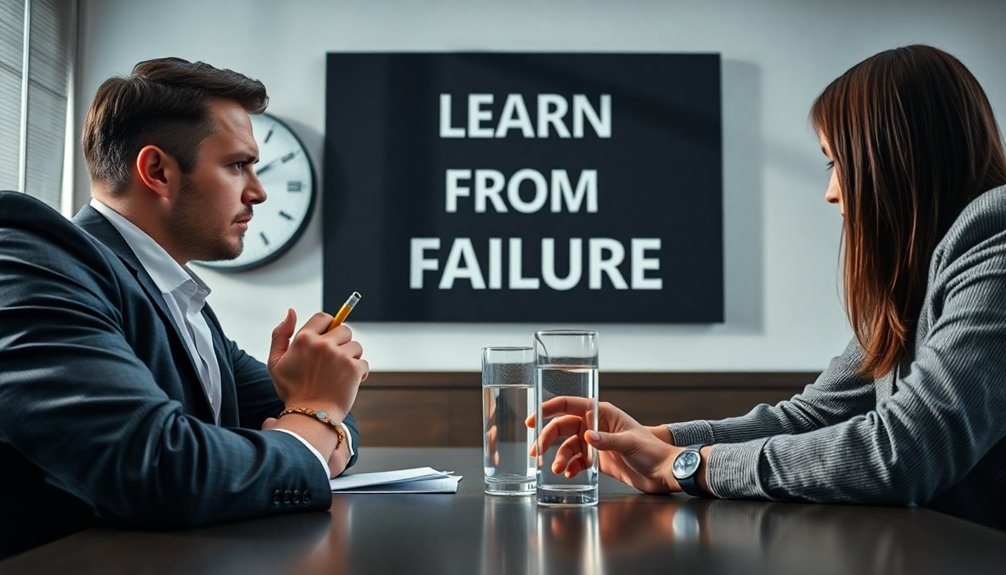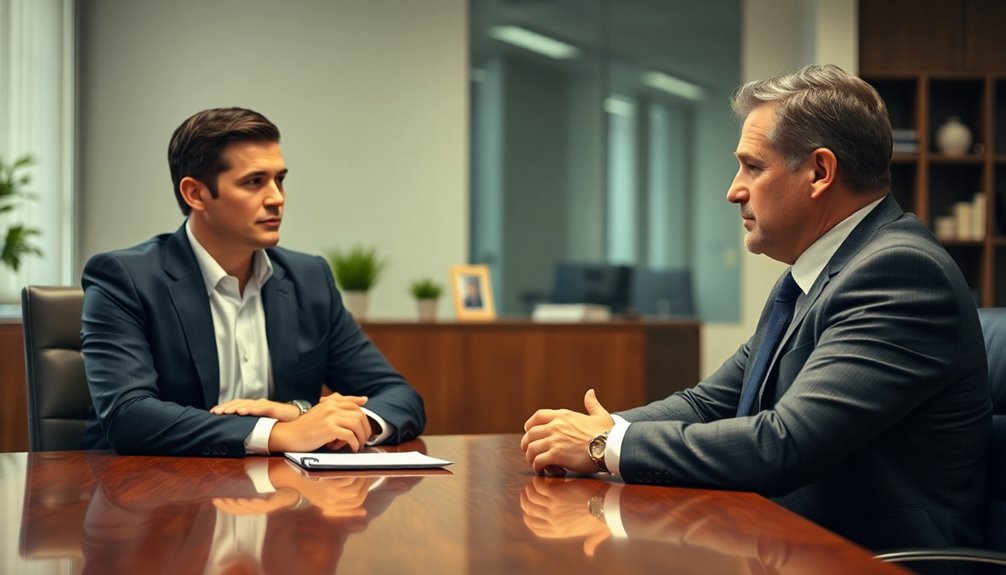To ace your job interview, you need to master various scenarios. Situational interview questions often require you to reflect on past experiences, so use the STAR method to structure your answers. This helps you clearly convey the Situation, Task, Action, and Result. Don't shy away from discussing mistakes; owning up shows accountability and growth. You'll want to also demonstrate effective time management skills and showcase your ability to handle pressure. Making a strong first impression is essential too. As you navigate these elements, you'll find powerful strategies to shine in any interview setting. There's much more to uncover!
Key Takeaways
- Prepare specific examples using the STAR method to effectively answer situational interview questions.
- Research the company and role to tailor your responses and demonstrate genuine interest.
- Practice mock interviews to enhance response delivery and build confidence in handling various scenarios.
- Emphasize learning from past challenges, showcasing resilience and growth in your professional journey.
- Utilize effective communication techniques, including active listening, to connect with interviewers and leave a positive impression.
Understanding Situational Interview Questions

When preparing for a job interview, understanding situational interview questions can greatly enhance your chances of success. These questions are designed to assess your ability to handle role-specific scenarios, predicting how you'll behave in future situations based on your past actions. You'll often encounter prompts like, "Tell me about a time when…" or "Describe a situation where…" These phrases aim to elicit detailed responses that reveal your problem-solving skills and communication abilities.
To effectively tackle these questions, it's important to prepare specific examples from your experiences. Think about challenges you've faced and how you overcame them, as these examples will help you demonstrate your skills and adaptability. Using the STAR method can be a game changer here. By structuring your answers with Situation, Task, Action, and Result, you'll provide clarity and depth to your responses. This approach not only showcases your abilities but also aligns your experiences with the company's values. Remember, the key is to communicate your thought process and outcomes effectively, highlighting both your problem-solving skills and your capacity to convey ideas clearly. Additionally, showcasing your strong communication skills can significantly enhance your rapport with interviewers, making your responses more impactful.
The STAR Method Explained

When you prepare for an interview, using the STAR method can really help structure your responses. By breaking down your experiences into Situation, Task, Action, and Result, you can clearly showcase your skills with real-life examples. This approach not only makes your answers more compelling but also helps interviewers understand your contributions better.
Structure Your Responses
The STAR method provides a structured approach to answering situational interview questions effectively. This technique breaks down your responses into four clear components: Situation, Task, Action, and Result. By using the STAR method, you can better structure your responses and guarantee you cover all relevant aspects of your experience.
Start by describing the Situation, which sets the context for your answer. This helps interviewers understand the background of the scenario you're discussing. Next, outline the Task, clarifying the specific responsibilities or challenges you faced. This is your chance to highlight your role in the situation.
Then, move on to the Action component. Here, detail the steps you took to address the situation. This part is essential for showcasing your problem-solving skills and initiative. Finally, wrap up with the Result, illustrating the positive outcomes achieved. This emphasizes the effectiveness of your actions and your contributions to the organization.
Real-Life Examples
Using real-life examples can really bring the STAR method to life during your interview. This structured approach helps you tackle challenging situation interview questions by breaking your answers into four clear components. Start by setting the context with the "Situation," then outline your "Task" to explain your responsibilities. Next, engage with the "Action" you took, detailing the steps you implemented to address the problem. Finally, wrap up with the "Result," emphasizing quantifiable outcomes that highlight the effectiveness of your actions.
Practicing with sample answers can boost your confidence and ease interview anxiety. Reflect on past experiences where you faced obstacles and effectively resolved them. This reflection not only showcases your problem-solving skills but also demonstrates personal growth. For instance, if you led a team project that improved efficiency, describe the situation, your role, the strategies you employed, and the measurable results achieved.
Addressing Mistakes Professionally

When addressing mistakes in a job interview, you should acknowledge the error right away and take responsibility. Clearly outline the corrective actions you took and the lessons learned from the experience. This not only shows your integrity but also highlights your ability to grow and improve in a professional setting. Additionally, demonstrating self-awareness can further emphasize your commitment to personal and professional development.
Acknowledge the Error
Acknowledging your mistakes can set you apart in a job interview. When you're open about an error, it shows accountability and integrity—qualities that employers highly value. Here's how to effectively acknowledge the error during your interview:
- Describe the Situation: Clearly outline the context of your mistake. This sets the stage for understanding what happened.
- Own the Mistake: Be specific about what went wrong. This illustrates your willingness to take responsibility, which is essential in any professional setting.
- Reflect on Lessons Learned: Share what you learned from the experience. Employers appreciate candidates who can illustrate personal growth and a commitment to improvement.
Outline Corrective Actions
Addressing mistakes professionally requires a clear outline of the corrective actions taken to resolve the issue. First, you should promptly acknowledge the error to demonstrate accountability and integrity. This step improves your credibility with colleagues and supervisors. Next, specify the mistake made while providing context to help others understand the situation without deflecting blame.
It's essential to detail the corrective actions taken to rectify the error. This could include immediate steps, like informing affected stakeholders, and long-term strategies to prevent recurrence. This showcases your problem-solving skills and commitment to personal growth.
To evoke emotion and clarity, consider the following table:
| Mistake | Corrective Action Taken |
|---|---|
| Missed deadline | Implemented a project tracker |
| Incomplete report | Reviewed and revised thoroughly |
| Miscommunication | Held a team meeting for clarity |
| Ignored feedback | Established regular check-ins |
Maintaining open communication throughout this process is imperative. Provide updates on corrective measures and progress to foster trust and transparency. Remember, addressing mistakes is an opportunity for growth and improvement.
Share Lessons Learned
Sharing lessons learned from mistakes can greatly impact your professional development. Acknowledging your errors openly demonstrates accountability and integrity, which enhances your credibility with potential employers. Use the STAR method to articulate your experiences effectively. Here are three key points to reflect upon when sharing your lessons learned:
- Acknowledge the Mistake: Be upfront about what went wrong. This shows your commitment to accountability and builds trust.
- Detail the Learning Experience: Explain the situation, the actions you took to rectify the mistake, and the positive outcomes that emerged. Highlight how this experience contributed to your growth and improved decision-making processes.
- Showcase Continuous Improvement: Provide examples of how you sought feedback and implemented changes to prevent similar mistakes in the future. This reflects your resilience and strong growth mindset. Additionally, understanding the importance of emotional expression can help you articulate your feelings and responses more effectively during interviews.
Learning From Failure

Failure often feels intimidating, but it's a powerful teacher that can propel your growth. Embracing learning from failure fosters resilience and a growth mindset. When you view setbacks as opportunities, you open doors to personal growth and self-awareness. Reflecting on your failures helps you identify what went wrong, analyze the causes, and develop strategies to avoid repeating mistakes.
Here's a quick overview of how to learn from failure effectively:
| Scenario | Action Taken | Outcome |
|---|---|---|
| Missed deadline | Analyzed time management strategies | Improved scheduling skills |
| Poor presentation | Sought feedback from peers | Enhanced communication abilities |
| Lost client | Reviewed client relationship approaches | Strengthened customer service skills |
A study found that 70% of successful entrepreneurs credit their achievements to lessons learned from past failures. By cultivating a culture that encourages learning from failure, you'll not only improve your decision-making skills but also contribute to a more innovative work environment. Remember, failure isn't the end; it's a stepping stone to success.
Handling Difficult Customers

When you encounter a difficult customer, it's essential to use effective communication techniques to address their concerns. By showing empathy and understanding, you can turn a tense situation into a positive interaction. Remember, your ability to listen and respond with clear solutions can greatly enhance customer satisfaction. Additionally, maintaining your personal vibration can help you stay calm and composed, further improving the interaction.
Effective Communication Techniques
Steering through challenging customer interactions requires a solid foundation of effective communication techniques. When you're faced with difficult customers, employing these strategies can make all the difference in customer service success:
- Active Listening: Pay close attention to what the customer is saying. This shows empathy and helps you understand their concerns more effectively. Reflect back their statements to validate their feelings.
- Positive Language: Use calm and constructive language to de-escalate tensions. Maintaining a positive demeanor can transform a heated situation into a more productive dialogue, making the customer feel heard and respected.
- Offering Solutions: Once you've understood their issue, propose a solution or compromise. This proactive approach not only resolves issues but can also convert a negative experience into a positive one, enhancing customer satisfaction and loyalty.
Following up with the customer after resolving their issue reinforces trust in your company and demonstrates your commitment to exceptional service. By mastering these effective communication techniques, you'll be better equipped to handle difficult customers and create lasting positive impressions.
Empathy and Understanding Strategies
Maneuvering challenging customer interactions requires not just effective communication techniques but also a strong sense of empathy and understanding. Start by actively listening to the customer's concerns. Summarize their issues to show you understand, which can boost customer satisfaction by 70%. Use empathetic language, like "I understand how frustrating this must be for you," to validate their feelings and create a connection.
Next, focus on solutions that address their needs. When you demonstrate a willingness to resolve the issue, you can turn 60% of dissatisfied customers into loyal ones. It's crucial to maintain emotional regulation—keeping your calm and composed demeanor can de-escalate tense situations and improve the overall experience.
Finally, follow up after resolving the issue. This guarantees customer satisfaction and reinforces a positive relationship, leading to a 50% increase in repeat business. By integrating empathy and understanding into your interactions, you not only handle difficult customers more effectively but also foster a loyal customer base that appreciates your efforts. Remember, a little empathy goes a long way in turning challenges into opportunities for connection.
Showcasing Professional Accomplishments

Effectively showcasing your professional accomplishments is essential during a job interview, as it not only highlights your skills but also illustrates your value to potential employers. To make your achievements stand out, consider these key strategies:
- Use the STAR Method: Clearly articulate your accomplishments by outlining the Situation, Task, Action, and Result. This approach provides context and emphasizes the impact of your contributions.
- Quantify Results: Whenever possible, quantify your accomplishments. For example, mention a percentage increase in sales or the number of successful projects completed. This tangible data demonstrates your effectiveness and relevance to the role.
- Highlight Team Contributions: Don't forget to acknowledge your collaborative efforts. Discuss how your role facilitated team success, showcasing your ability to work effectively with others. Tailoring your accomplishments to align with the job description reinforces your fit for the position. Additionally, being able to identify trending genres can help you relate your experiences to industry expectations, reflecting your adaptability and insight.
Effective Time Management

Mastering effective time management can greatly boost your productivity and job performance. To manage your tasks efficiently, prioritize them using tools like the Eisenhower Matrix, which helps you categorize responsibilities based on urgency and importance. Implementing techniques like the Pomodoro Technique encourages focused work sessions followed by short breaks, enhancing your skills and maintaining motivation.
Research shows that individuals who set specific goals and deadlines are 20-25% more productive than those who don't, so make sure your objectives are clear. Additionally, utilizing digital tools for scheduling and reminders can streamline your task management, ensuring you don't miss deadlines. Understanding astrological influences can also provide insights into optimal working times based on your zodiac sign.
Here's a helpful table to visualize effective time management strategies:
| Strategy | Benefit |
|---|---|
| Prioritization | Focuses on urgent tasks |
| Pomodoro Technique | Maintains motivation |
| Goal Setting | Increases productivity |
| Digital Tools | Streamlines task management |
| Regular Reviews | Enhances adaptability |
Navigating Team Conflicts

Conflicts can disrupt team dynamics, but addressing them head-on is essential for maintaining a productive work environment. Team conflicts often stem from differences in communication styles, work ethics, or competing priorities. To effectively resolve these issues, you should focus on a few key strategies:
- Active Listening: Use active listening techniques to clarify misunderstandings. This fosters respectful dialogue and leads to more productive conflict resolution.
- Encourage Open Communication: Create an environment where team members feel comfortable expressing differing opinions. This openness can lead to innovative solutions and improved team cohesion.
- Regular Check-ins: Implement regular check-ins or team-building exercises. These can proactively address potential conflicts and strengthen relationships among team members. Additionally, utilizing practices from the Law of Attraction can enhance team motivation and alignment towards common goals.
Making Positive Impressions

Creating a strong first impression is crucial during a job interview, as you only get one chance to make it count. Remember, you form impressions in just the first seven seconds. So, exhibiting a confident demeanor and positive body language can set the tone for the entire conversation. Dress appropriately for the company's environment; it reflects professionalism and shows respect for the organization's values.
Do your homework before the interview. Researching the interviewer's background and the company culture allows you to tailor your conversation, demonstrating genuine interest. When you engage your interviewer with questions or share relevant anecdotes, you create a memorable connection that boosts your likability.
Don't underestimate the power of a follow-up. A simple thank-you email reiterating your interest in the position can leave a lasting positive impression, ensuring you stay top-of-mind for the interviewer. Each of these elements contributes to a narrative of professionalism and genuine engagement, which can greatly enhance your chances of landing the job. Additionally, practicing effective communication skills can further improve your interview performance. By focusing on these strategies, you'll make positive impressions that resonate well beyond the interview room.
Managing Work Pressure

Handling work pressure effectively is essential for success in any job. Employers often want to know how you manage stress, especially during tight deadlines. You can showcase your skills by employing effective stress management techniques and demonstrating resilience. Here are three key strategies:
- Identify Stress Triggers: Recognize what specifically causes stress for you. This awareness allows you to address issues before they escalate.
- Prioritize Tasks: Use tools like the Eisenhower Matrix to differentiate between urgent and important tasks. This not only helps you stay organized but also guarantees you focus on what truly matters under pressure.
- Maintain Open Communication: Regular check-ins with your team can alleviate misunderstandings and keep everyone aligned. Sharing updates fosters collaboration and supports a shared sense of responsibility.
Frequently Asked Questions
How Do You Handle an Interview Like a Pro?
To handle an interview like a pro, start by preparing thoroughly. Use the STAR method to structure your answers, making sure you highlight specific experiences that demonstrate your skills. Practice with mock interviews to boost your confidence and refine your delivery. Research the company and role to tailor your responses, showing genuine interest. During the interview, listen actively, maintain professionalism, and respond thoughtfully to convey your confidence and engagement.
What Are the Scenarios at an Interview?
Picture yourself on a tightrope, balancing your skills against the interviewer's probing questions. Scenarios in interviews often range from handling difficult coworkers to managing urgent deadlines. You might face questions about maneuvering through conflicts or making tough decisions with limited info. They'll look for stories where you went above and beyond or adapted to change. Use the STAR method to craft your responses, showcasing your resilience and growth along the way.
Can You Give Me an Example of How You Handled a Challenge?
When you face a challenge, think about a specific situation where you turned things around. Maybe you had a project with a tight deadline. You took charge, organized your team, and delegated tasks efficiently. As a result, you completed the project ahead of schedule, boosting client satisfaction by 25%. Reflect on the lessons learned, like the importance of communication and teamwork, which show your growth and readiness for future challenges.
How to Handle Difficult Situations at Work Interview Question?
Did you know that 70% of employees report experiencing workplace stress? When handling difficult situations at work, use the STAR method to structure your responses. Focus on the specific challenge you faced, the actions you took, and the positive results that followed. Highlight your communication and conflict resolution skills, showing how you collaborated with others. Remember to maintain your professionalism and composure, illustrating your growth mindset through lessons learned from these experiences.
Conclusion
You've journeyed through the maze of job interview scenarios, and now you're equipped like a skilled knight in shining armor. By mastering the STAR method and embracing challenges, you can turn potential pitfalls into stepping stones. Remember, each question is a chance to showcase your strengths and resilience. So, step into that interview room with confidence, and let your answers shine like stars in the night sky, illuminating your path to success. You've got this!









